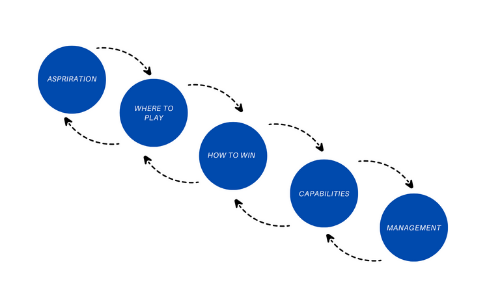Aspiration
There is a saying, “Modest aspiration is far more dangerous than a lofty one”. How many times have we, as product managers, attempted to create marginally better versions of our competitors’ products? We need to step up and make the tough choices focusing on customers and changing the marketplace. The biggest risk of using a product lens is that it will focus on the incorrect things, such as features, technology, and so on. But how many times have we designed a product roadmap around consumers’ unmet and undermet needs?
In my opinion, winning aspiration should always be crafted with the customer at the core. One of my favorites is Nike “If you have a body, you are an athlete”. We should not just build the products to satisfy customers, but also to win them over. We are unlikely to commit our time and energy to create a sustainable advantage over our competition unless winning is our ultimate goal. So, instead of competing, let us play to win.
We must question ourselves when setting a winning aspiration
- Who is our best competitor?”
- What do we do better than our competitors in terms of strategy and operations?
- Where and how do they exceed us, and what can we learn or do differently from them
Looking at the best competitor will provide us valuable insight on how to win in a variety of ways
Where to Play
Choosing the correct playing field is one of the most difficult decisions, and we all make the error of trying to play in all of them at the same time, resulting in under performance and failure. Choosing the correct customer segment for our product is a crucial decision that should be done in tandem with our goal. The strategy must be based on a desire to address customer needs in a manner that benefits both the organisation and the customer. When creating products, “Where to Play” choice can be one of the possibilities below or a combination of possibilities.
- Geography – In what country or region should our product target ?
- Product type – What kind of product or service we should focus on ?
- Consumer segment – crucial to define the segment, very hard to sell high-end luxury products in dollar stores or vice versa. Get the clarity as to who your target segment is; Is it mass market or niche player?
- Distribution channels – Right channels to reach the customers. I’ve had the experience of visiting a furniture fittings and accessories display center of a reputable brand, settling on a few products at the display center, and then needing to purchase from an approved dealer. When I went to the dealer, most of the products were not in stock. What’s more, I discovered identical products from competitors in stock.
- Vertical stage of production – Which stage of production should we be engaged in. Where does our product fit in the value chain?
When deciding where to play, it’s as important to consider where not to play. If someone asks me where should I play, I’ll tell them I want to focus on the customer. Spend time and effort learning about your customer’s likes and dislikes, as well as their unmet and undermet needs. I’d advise delve deep to learn about their daily lives and gain insights so you can pinpoint the customer segment for whom your product is intended. When it comes to competition, one thing we must remember is to bring new distinctive value.
As Product Leaders, our mantra is to avoid falling prey to three temptations
- Focus is a winning quality; if you choose all customers and all customer segments, no matter how many resources we have, you will fail. Can we state that our customers come from all around the world? Clearly, no.
- If you intended to get out of the current game by strategizing a way out, it’s not required that you’d excel in another one; instead, you should establish a clear goal. A smart strategy to winning in the current game is enabled by a disciplined approach to strategic thinking.
- The biggest pitfall of all is seeing current choices as immutable or unavoidable. It’s easy to believe we don’t have a choice over where we play, but that’s just an excuse for mediocre work. Think outside the box how you can apply structured thinking to excel.
How to Win
What we will do on the field is determined by how to win. We have two options at ten thousand feet: low-cost player or differentiator.
Cost leadership refers to a competitive advantage gained by a low-cost structure. It’s all about cost drivers, constant expense cutting, sacrificing non-confirming customers, and a dedication to standardization. A low-cost player does not necessarily mean the lowest prices, but rather the ability to undercut competitors or reinvest margin differentials to gain a competitive edge. If we wanted to be the market leader in terms of pricing, we’d start tracking costs as early as the ideation stage.
Differentiation strategy is something distinctively more valuable to customers. The more a product is differentiated along dimensions consumers care about, the higher premium price it can demand. It is all about a deep and holistic understanding of the customer, brand building, guarding of customers, and commitment to innovation.
Cost leadership or distinctiveness are the two ways that all successful product strategies use. Both cost leadership and differentiation can create a larger revenue-to-cost margin, resulting in a long-term competitive advantage. It’s quite uncommon to use both tactics at the same time.
In conclusion, the “Where to Play” and “How to Win” options should complement one another to form a unique combination.
Capabilities
Core capabilities are those activities that, when performed at the highest level, enable the organization “Where to Play” and “How to Win” to life. Competitive strategy is about being different which means deliberately choosing a different set of activities to deliver a unique value. We need to ensure the set of activities that we do should also be uniquely different than our competitors.
Identifying the core capabilities that we could deliver is a vital step in the strategy process. Identifying the capabilities required for “Where to Play” and “How to Win” gives clarity on where we should spend our focus and investments. For example, @Apple core capabilities are quality, customer service, innovation, and so on, whereas @Nike core capabilities are a brand, R&D, a huge customer base, superior marketing capabilities, and so on, all of which are competitively defensible.
Management
Let us just say we have a winning aspiration, clarity on “where to play” and “how to win”, and have articulated the capabilities required. If we do not put in place a proper management system, we are destined for failure.
Specificity is crucial when designing business models around our products. We can’t just say “market leadership” or “increased market share,” we have to quantify a number range within which we label success, and anything below that is failure. WPI (Weighted Purchase Intent), a metric used by industry leader P&G in their product offering, looks at numerous factors such as the product’s aesthetic appeal, design, touch, feel, look, and technical performance. Other crucial indicators, such as net promoter score (NPS), can be used to track consumer sentiment and loyalty in addition to WPI. The strategic choice cascade is incomplete unless we have systems and metrics in place.
My dear product leaders, a great product can launch a firm, build value, and win in the marketplace for a period of time. Finally, you must respond to five questions regarding the strategic choice cascade.
I’d like to express my gratitude to @Dr. Pavan Soni for introducing me to the world of strategy and design your thinking.







